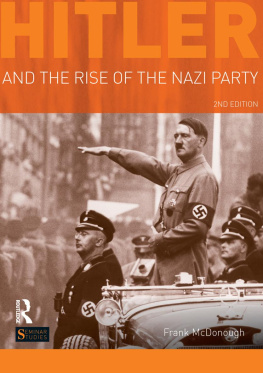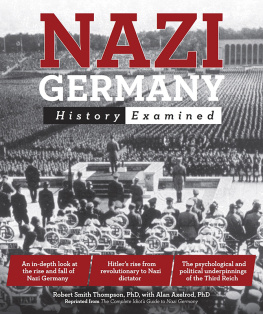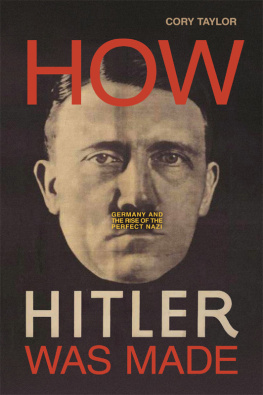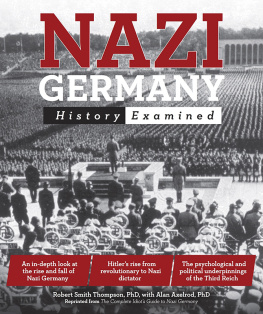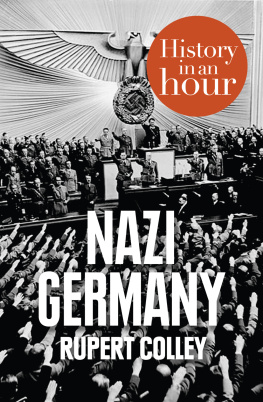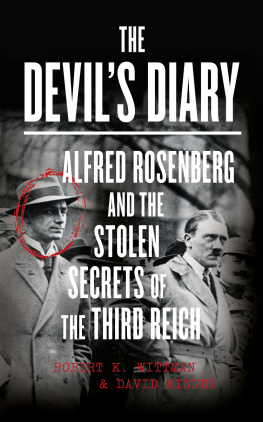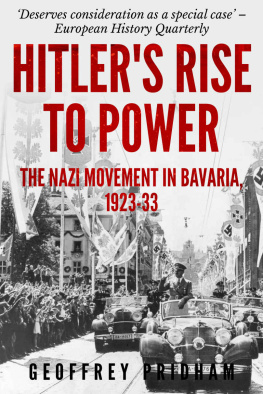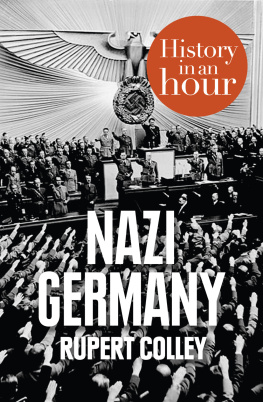

The Memoirs of Ernst Rhm
This edition published in 2012 by Frontline Books,
an imprint of Pen & Sword Books Ltd,
47 Church Street, Barnsley, S. Yorkshire, S70 2AS
www.frontline-books.com
Translation copyright Pen & Sword Books Ltd, 2012 Introduction Eleanor Hancock, 2012
9781783032501
Publishing History
The full German-language edition of Rohms memoirs,
Rhm: Die Geschichte eines Hochverrters , was published in Munich
in 1928 by Franz Eher Verlag. This edition, published by Frontline Books,
London, has been abridged from the original text and is the
first English-language translation.
All rights reserved. No part of this publication may be reproduced,
stored in or introduced into a retrieval system, or transmitted,
in any form, or by any means (electronic, mechanical, photocopying,
recording or otherwise) without the prior written permission of the publisher.
Any person who does any unauthorized act in relation to this publication
may be liable to criminal prosecution and civil claims for damages.
CIP data records for this title are available
from the British Library
For more information on our books, please visit
www.frontline-books.com, email info@frontline-books.com
or write to us at the above address.
Printed and bound by CPI Group (UK) Ltd, Croydon, CR0 4YY
Typeset in 11.75 & 11.2/15.2 point Arno Pro
Illustrations
| Plate 1: | Rhm and Hitler at a Nuremberg rally in 1933. |
| Plate 2: | Rhm at an inspection in 1932; Rhm with Hitler and Ludendorff during the 1924 trial of participants in the so-called Hitler Putsch. |
| Plate 3: | Rhm with Hitler at an SA parade; Rhm proudly displaying his First World War medals; Gring and Rhm. |
| Plate 4: | Rhm with SA Gruppenfhrer Ernst; Hitler and Franz Pfeffer von Salomon. |
| Plate 5: | Graf von Helldorf; SS parade; Rhm and Himmler. |
| Plate 6: | Gring and Himmler; Gring and Rhm at the wedding of Berlin SA chief Karl Ernst. |
| Plate 7: | Rhm enjoying the trappings of power in 1933. |
| Plate 8: | The announcement of Rhms death. |
Note on the Translation
The Memoirs of Ernst Rhm has been abridged from the German-language original edition of Rohms memoirs, Rhm: Die Geschichte eines Hochverrters . This translation focuses on material covering the political aspects of Rhms career from the end of the First World War and his role in the development of National Socialism. Material covering his early life, military career and service at the front has been contracted and is presented in the Foreword to this edition.
Introduction
In publishing a translation of the political sections of Rhms autobiography, Frontline Books are making an important account of the early days of National Socialism available to English-speaking readers for the first time. Ernst Rhm joined the National Socialist German Workers Party (NSDAP, Nazi Party) in 1919 at the same time as Adolf Hitler and was an active supporter of the party in its early years in Munich. As an army officer in Munich, Rhm controlled funds and weapons, both of which he used to favour the Nazis in right-wing Bavarian politics between 1919 and 1923. Rhm was an early patron of Hitler. In the political manoeuvring of 1923, he swung his weight behind Hitler to ensure that Hitler was given the leading position in the various ultra right-wing ( vlkisch ) unity organizations that were formed and that ultimately staged an unsuccessful attempt to take over government in Munich on 9 November 1923 (the Beerhall Putsch). Rhm was then one of the first Nazis to become a national member of parliament before he stood down from all his positions in 1924 after a disagreement with Hitler on the role of paramilitary organizations in the struggle for power. From 1925 to 1927 Rhm tried unsuccessfully to make a success of non-political, civilian life before publicly returning to Nazism.
When this book was published by the Nazi publishing house Eher Verlag in 1928, Ernst Rhm was in his forty-first year and had just returned to radical right-wing politics. The writing and publication of this autobiography was part of this return as well as an attempt to earn money. Rhm titled the book with heavy irony Die Geschichte eines Hochverrters the story of a traitor referring proudly to his conviction for high treason against the Republic as a result of the 1923 Putsch. In the autobiography Rhm showed how the impact of the German Revolution of 1918 19 led him from a conventional Army career to active subversion of the democratic Weimar Republic that succeeded imperial Germany, both as a member of the Nazi Party and as a leader of the paramilitary groups, Reich War Flag (Reichkriegsflagge) and Frontbann. This book demonstrates how such early Nazis came from a broader radical right-wing milieu which Nazism gradually came to dominate. It is a valuable guide to the world view of such Nazis of the first hour.
Ernst Rhms emphases in the autobiography reveal much about his own personality and political views. He was sociable and maintained many friendships this is clear from the book. His sense of irony and humour can also be seen in his comments, though his humour was at times heavy and slyly addressed against his political opponents. Except for rare occasions (discussed below), Rhm was not reflective about his personality and motives. (This is a characteristic he shared with other leading Nazis.)
In his autobiography Ernst Rhm proclaimed that he combined his Nazism with strong support for the Bavarian monarchy, for example. (Later editions of the book downplayed this monarchism.) Rhm presented himself as a rational anti-Semite, and as a man who had more empathy with his radical opponents on the left in the Communist party than with the moderate politicians of the centre. Rhms hostility to middle-class values such as respectability and prudence is clearly expressed throughout the book.
Rhm claimed of his autobiography that few books had been written with more ruthless candour;1 but he did not mention incidents in his past, which might have reflected badly on him, such as charges he had faced for assaulting a recruit, his fiance breaking their engagement or his neurasthenia in convalescence in 1916.2 It is unsurprising perhaps that he sought to present himself in the best possible light. There were other aspects of his life, such as his artistic interests, which Rhm did not disclose in his autobiography, presumably because they did not fit into the largely political story he was telling. He did indicate in the book that he had not written all he knew about the political developments of the period.3
This is not a candid expos of early Nazism. Because Rhm wrote the book with an eye to his re-emergence in the movement, it does not contain vivid characterizations of his party comrades nor mention of the hostility that existed between him and some other members of the leadership. Rhms picture of Hitler is also matter of fact compared to the later cult of Hitler that developed in the party, though it is clear from his account that the two men were friends.



